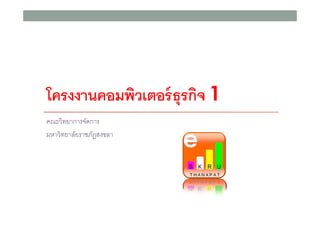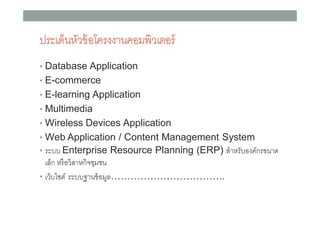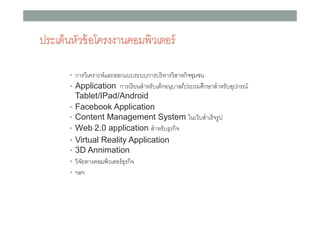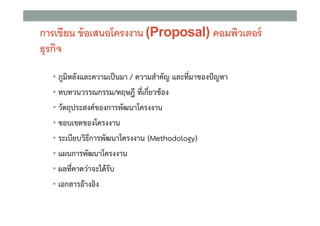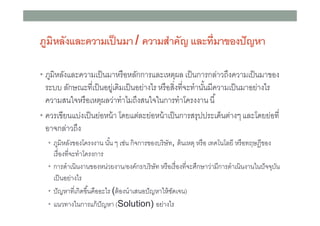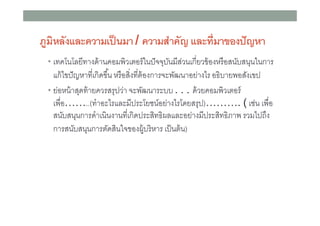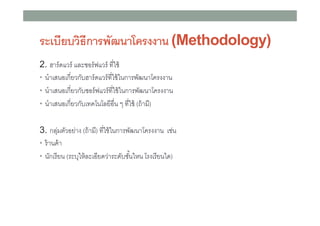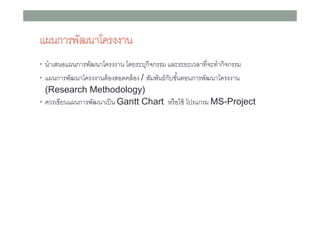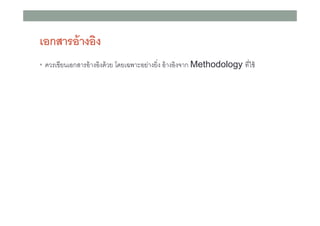Introduction bizcomproject1
- 2. α╕½α╕¸α╕▒α╕üα╕üα╕▓α╕úα╣Çα╕¸α╕╖α╕¾α╕üα╣éα╕Âα╕úα╕çα╕çα╕▓α╕╚Î╕Âα╕¾α╕´α╕Ûα╕┤α╕¯α╣Çα╕Ïα╕¾α╕úα╣î ΓÇó α╣Çα╕¢α╣ç α╕Ôα╕½α╕▒α╕¯α╕éα╣ë α╕¾ / α╣Çα╕úα╕╖ α╕¾α╕çα╕ùα╕╡α╕´α╕╡α╕Âα╕¯α╕▓α╕´α╕úα╕╣α╣ëα╕Ûα╕╖α╕Ôα╕Éα╕▓α╕Ô ΓÇó α╣Çα╕¢α╣ç α╕Ôα╕½α╕▒α╕¯α╕éα╣ë α╕¾ / α╣Çα╕úα╕╖ α╕¾α╕çα╕ùα╕╡α╕´α╕╡α╕Âα╕¯α╕▓α╕´α╕¬α╕Ôα╣âα╕ê ΓÇó α╣Çα╕¢α╣ç α╕Ôα╕½α╕▒α╕¯α╕éα╣ë α╕¾ / α╣Çα╕úα╕╖ α╕¾α╕ç α╕ùα╕╡α╕ûα╕╣α╕üα╕üα╕▒α╕Üα╕êα╕úα╕┤α╕Ï α╕éα╕¾α╕çα╕Ïα╕Ôα╣Çα╕¾α╕ç (α╕ùα╣‗α╕▓α╣üα╕¸α╣ë α╕¯/α╕Îα╕╢α╕üα╕⌐α╕▓α╣üα╕¸α╣ë α╕¯α╕´α╕╡α╕Âα╕¯α╕▓α╕´α╕¬α╕╕α╕é) ΓÇó α╣Çα╕¢α╣ç α╕Ôα╕½α╕▒α╕¯α╕éα╣ë α╕¾ / α╣Çα╕úα╕╖ α╕¾α╕çα╕ùα╕╡ α╣üα╕üα╣ë α╕¢α╕▒α╕‗α╕½α╕▓α╣âα╕½α╣ë α╕üα╕▒α╕Üα╕¾α╕çα╕Âα╣î α╕üα╕ú α╕êα╕úα╕┤α╕ç α╣¶ ΓÇó α╣Çα╕¢α╣ç α╕Ôα╕½α╕▒α╕¯α╕éα╣ë α╕¾ / α╣Çα╕úα╕╖ α╕¾α╕çα╕ùα╕╡ α╣âα╕½α╕´α╣ê (α╣Âα╕´α╣ê α╣Çα╕Âα╕óα╕´α╕╡α╣âα╕Âα╕úα╕´α╕▓α╕üα╣ê α╕¾α╕Ô α╕½α╕úα╕╖α╕¾α╕ùα╣‗α╕▓α╣üα╕¸α╣ë α╕¯α╕¾α╕▓α╕êα╕êα╕░α╣Âα╕´α╣ê α╕Ëα╕╡ α╣Çα╕ùα╣ê α╕▓α╕ùα╕╡α╕Âα╕¯α╕ú)
- 3. α╕½α╕¸α╕▒α╕üα╕üα╕▓α╕úα╣Çα╕¸α╕╖α╕¾α╕üα╣éα╕Âα╕úα╕çα╕çα╕▓α╕╚Î╕Âα╕¾α╕´α╕Ûα╕┤α╕¯α╣Çα╕Ïα╕¾α╕úα╣î ΓÇó α╣éα╕¢α╕úα╣üα╕üα╕úα╕´α╕Âα╕¾α╕´α╕Ûα╕┤α╕¯α╣Çα╕Ïα╕¾α╕úα╣î + α╣éα╕Âα╕úα╕çα╕çα╕▓α╕╚Î╕Âα╕¾α╕´α╕Ûα╕┤α╕¯α╣Çα╕Ïα╕¾α╕úα╣î α╕Âα╕╖α╕¾ α╕üα╕▓α╕úα╣üα╕üα╣ë α╕¢α╕▒α╕‗α╕½α╕▓α╣âα╕½α╣ë α╣üα╕üα╣ê α╕¾α╕çα╕Âα╣îα╕üα╕úα╕¤α╕╕α╕úα╕üα╕┤α╕ê (Business Solution) (α╣Âα╕´α╣êα╣âα╕èα╣êα╕¬α╕úα╣ë α╕▓α╕çα╕¢α╕▒ α╕‗α╕½α╕▓α╣âα╕½α╣ë α╣üα╕üα╣ê α╕¾α╕çα╕Âα╣îα╕üα╕úα╕¤α╕╕α╕úα╕üα╕┤α╕ê)
- 4. α╕¢α╕úα╕░α╣Çα╕Ëα╣çα╕Ôα╕½α╕▒α╕¯α╕éα╣ë α╕¾α╣éα╕Âα╕úα╕çα╕çα╕▓α╕╚Î╕Âα╕¾α╕´α╕Ûα╕┤α╕¯α╣Çα╕Ïα╕¾α╕úα╣î ΓÇó Database Application ΓÇó E-commerce ΓÇó E-learning Application ΓÇó Multimedia ΓÇó Wireless Devices Application ΓÇó Web Application / Content Management System ΓÇó α╕úα╕░α╕Üα╕Ü Enterprise Resource Planning (ERP) α╕¬α╣‗α╕▓α╕½α╕úα╕▒α╕Üα╕¾α╕çα╕Âα╣îα╕üα╕úα╕éα╕Ôα╕▓α╕Ë α╣Çα╕¸α╣çα╕ü α╕½α╕úα╕╖ α╕¾α╕¯α╕┤α╕¬α╕▓α╕½α╕üα╕┤α╕êα╕èα╕╕α╕´α╕èα╕Ô ΓÇó α╣Çα╕¯α╣çα╕Üα╣Âα╕ïα╕Ïα╣î α╕úα╕░α╕Üα╕Üα╕Éα╕▓α╕Ôα╕éα╣ë α╕¾α╕´α╕╣α╕¸ΓdzΓdzΓdzΓdzΓdzΓdzΓdzΓdzΓdzΓdzΓdz..
- 5. α╕¢α╕úα╕░α╣Çα╕Ëα╣çα╕Ôα╕½α╕▒α╕¯α╕éα╣ë α╕¾α╣éα╕Âα╕úα╕çα╕çα╕▓α╕╚Î╕Âα╕¾α╕´α╕Ûα╕┤α╕¯α╣Çα╕Ïα╕¾α╕úα╣î ΓÇó α╕üα╕▓α╕úα╣î α╕Ïα╕Ôα╣üα╕¾α╕Ôα╕┤α╣Çα╕´α╕èα╕▒α╕Ô α╣Çα╕úα╕╖ α╕¾α╕ç ΓdzΓdzΓdzΓdzΓdzΓdzΓdzΓdzΓdzΓdzΓdzΓdzΓdzΓdzΓdz α╕╣ ΓÇó CAI α╣Çα╕úα╕╖ α╕¾α╕çΓdzΓdzΓdzΓdzΓdzΓdzΓdzΓdzΓdzΓdzΓdzΓdzΓdzΓdzΓdzΓdzΓdzΓdzΓdzΓdz. ΓÇó α╣Çα╕¯α╣çα╕Üα╣Âα╕ïα╕Ïα╣î E-Commerce ΓÇó α╕úα╕░α╕Üα╕Üα╕üα╕▓α╕úα╕êα╕▒α╕Ëα╕üα╕▓α╕úα╕Âα╕¯α╕▓α╕´α╕úα╕╣α╣ë ΓdzΓdzΓdzΓdzΓdzΓdzΓdzΓdzΓdzΓdzΓdzΓdzΓdzΓdzΓdz. ΓÇó α╕Üα╕ùα╣Çα╕úα╕╡ α╕óα╕Ôα╕¾α╕¾α╕Ôα╣Âα╕¸α╕Ôα╣î α╣Çα╕úα╕╖ α╕¾α╕ç ΓdzΓdzΓdzΓdzΓdzΓdzΓdzΓdzΓdzΓdzΓdzΓdzΓdzΓdzΓdzΓdz. ΓÇó α╕úα╕░α╕Üα╕Üα╣üα╕êα╣ë α╕çα╕ïα╣êα╕¾α╕´α╣Çα╕Âα╕úα╕╖ α╕¾α╕çα╕Âα╕¾α╕´α╕Ûα╕┤α╕¯α╣Çα╕Ïα╕¾α╕úα╣î α╕Âα╕ôα╕░α╕¯α╕┤α╕ùα╕óα╕▓α╕üα╕▓α╕úα╕êα╕▒α╕Ëα╕üα╕▓α╕ú/α╕¾α╕çα╕Âα╣îα╕üα╕úΓdzΓdzΓdz ΓÇó α╕Üα╕ùα╣Çα╕úα╕╡ α╕óα╕Ô E-Learning α╣Çα╕úα╕╖ α╕¾α╕ç ΓdzΓdzΓdzΓdzΓdzΓdzΓdzΓdzΓdzΓdzΓdzΓdz ΓÇó α╕¦α╕▓α╕Ûα╕óα╕Ôα╕Ïα╕úα╣î α╕¬α╕Ô/α╕¬α╕▓α╕úα╕Âα╕Ëα╕╡ α╣Çα╕úα╕╖ α╕¾α╕ç ΓdzΓdzΓdzΓdzΓdzΓdzΓdzΓdzΓdzΓdzΓdzΓdzΓdzΓdz α╕▒
- 6. α╕¢α╕úα╕░α╣Çα╕Ëα╣çα╕Ôα╕½α╕▒α╕¯α╕éα╣ë α╕¾α╣éα╕Âα╕úα╕çα╕çα╕▓α╕╚Î╕Âα╕¾α╕´α╕Ûα╕┤α╕¯α╣Çα╕Ïα╕¾α╕úα╣î ΓÇó α╕üα╕▓α╕úα╕¯α╕┤α╣Çα╕Âα╕úα╕▓α╕░α╕½α╣îα╣üα╕¸α╕░α╕¾α╕¾α╕üα╣üα╕Üα╕Üα╕úα╕░α╕Üα╕Üα╕üα╕▓α╕úα╕Üα╕úα╕┤ α╕½α╕▓α╕úα╕¯α╕┤α╕¬α╕▓α╕½α╕üα╕┤α╕êα╕èα╕╕α╕´α╕èα╕Ô ΓÇó Application α╕üα╕▓α╕úα╣Çα╕úα╕╡ α╕óα╕Ôα╕¬α╣‗α╕▓α╕½α╕úα╕▒α╕Üα╣Çα╕Ëα╣çα╕üα╕¾α╕Ôα╕╕α╕Üα╕▓α╕¸/α╕¢α╕úα╕░α╕ûα╕´α╕Îα╕╢α╕üα╕⌐α╕▓α╕¬α╣‗α╕▓α╕½α╕úα╕▒α╕Üα╕¾α╕╕α╕¢α╕üα╕úα╕ôα╣î ΓÇó ΓÇó ΓÇó ΓÇó ΓÇó ΓÇó ΓÇó Tablet/IPad/Android Facebook Application Content Management System α╣âα╕Ôα╣Çα╕¯α╣çα╕Üα╕¬α╣‗α╕▓α╣Çα╕úα╣ç α╕êα╕úα╕╣ α╕¢ Web 2.0 application α╕¬α╣‗α╕▓α╕½α╕úα╕▒α╕Üα╕¤α╕╕α╕úα╕üα╕┤α╕ê Virtual Reality Application 3D Annimation α╕¯α╕┤α╕êα╕óα╕ùα╕▓α╕çα╕Âα╕¾α╕´α╕Ûα╕┤α╕¯α╣Çα╕Ïα╕¾α╕úα╣î α╕¤α╕╕α╕úα╕üα╕┤α╕ê α╕▒ α╕»α╕¸α╕»
- 7. α╕üα╕▓α╕úα╣Çα╕éα╕╡α╕óα╕Ô α╕éα╣ë α╕¾α╣Çα╕¬α╕Ôα╕¾α╣éα╕Âα╕úα╕çα╕çα╕▓α╕Ô (Proposal) α╕Âα╕¾α╕´α╕Ûα╕┤α╕¯α╣Çα╕Ïα╕¾α╕úα╣î α╕¤α╕╕α╕úα╕üα╕┤α╕ê ΓÇó α╕¦α╕╣α╕´α╕┤α╕½α╕¸α╕▒α╕çα╣üα╕¸α╕░α╕Âα╕¯α╕▓α╕´α╣Çα╕¢∩£Êα╕Ôα╕´α╕▓ / α╕Âα╕¯α╕▓α╕´α╕¬α╣‗α╕▓α╕Âα╕▒α╕‗ α╣üα╕¸α╕░α╕ùα╕╡α╣êα╕´α╕▓α╕éα╕¾α╕çα╕¢∩£Éα╕‗α╕½α╕▓ ΓÇó α╕ùα╕Üα╕ùα╕¯α╕Ôα╕¯α╕úα╕úα╕ôα╕üα╕úα╕úα╕´/α╕ùα╕¨α╕⌐α╕Àα╕╡ α╕ùα╕╡α╣êα╣Çα╕üα╕╡α╣êα╕óα╕¯α╕é∩£ïα╕¾α╕ç ΓÇó α╕¯α╕▒α╕Ïα╕ûα╕╕α╕¢α╕úα╕░α╕¬α╕çα╕Â∩£Àα╕éα╕¾α╕çα╕üα╕▓α╕úα╕Ûα╕▒α╕Êα╕Ôα╕▓α╣éα╕Âα╕úα╕çα╕çα╕▓α╕Ô ΓÇó α╕éα╕¾α╕Üα╣Çα╕éα╕Ïα╕éα╕¾α╕çα╣éα╕Âα╕úα╕çα╕çα╕▓α╕Ô ΓÇó α╕úα╕░α╣Çα╕Üα╕╡α╕óα╕Üα╕¯α╕┤α╕¤α╕╡α╕üα╕▓α╕úα╕Ûα╕▒α╕Êα╕Ôα╕▓α╣éα╕Âα╕úα╕çα╕çα╕▓α╕Ô (Methodology) ΓÇó α╣üα╕£α╕Ôα╕üα╕▓α╕úα╕Ûα╕▒α╕Êα╕Ôα╕▓α╣éα╕Âα╕úα╕çα╕çα╕▓α╕Ô ΓÇó α╕£α╕¸α╕ùα╕╡α╣êα╕Âα╕▓α╕Ëα╕¯∩£èα╕▓α╕êα╕░α╣Âα╕Ë∩£ïα╕úα╕▒α╕Ü ΓÇó α╣Çα╕¾α╕üα╕¬α╕▓α╕úα╕¾∩£ïα╕▓α╕çα╕¾α╕┤α╕ç
- 8. α╕¦α╕╣α╕´α╕┤α╕½α╕¸α╕▒α╕çα╣üα╕¸α╕░α╕Âα╕¯α╕▓α╕´α╣Çα╕¢α╣ç α╕Ôα╕´α╕▓ / α╕Âα╕¯α╕▓α╕´α╕¬α╣‗α╕▓α╕Âα╕▒α╕‗ α╣üα╕¸α╕░α╕ùα╕╡α╕´α╕▓α╕éα╕¾α╕çα╕¢α╕▒ α╕‗α╕½α╕▓ ΓÇó α╕¦α╕╣α╕´α╕┤α╕½α╕¸α╕▒α╕çα╣üα╕¸α╕░α╕Âα╕¯α╕▓α╕´α╣Çα╕¢α╣ç α╕Ôα╕´α╕▓α╕½α╕úα╕╖ α╕¾α╕½α╕¸α╕▒α╕üα╕üα╕▓α╕úα╣üα╕¸α╕░α╣Çα╕½α╕Ïα╕╕α╕£α╕¸ α╣Çα╕¢α╣ç α╕Ôα╕üα╕▓α╕úα╕üα╕¸α╣êα╕▓α╕¯α╕ûα╕╢α╕çα╕Âα╕¯α╕▓α╕´α╣Çα╕¢α╣ç α╕Ôα╕´α╕▓α╕éα╕¾α╕ç α╕úα╕░α╕Üα╕Ü α╕¸α╕▒α╕üα╕⌐α╕ôα╕░α╕ùα╕╡α╣Çα╕¢α╣ç α╕Ôα╕¾α╕óα╕╣α╣Çα╣ê α╕Ëα╕┤α╕´α╣Çα╕¢α╣ç α╕Ôα╕¾α╕óα╣êα╕▓α╕çα╣Âα╕ú α╕½α╕úα╕╖ α╕¾α╕¬α╕┤α╕çα╕ùα╕╡α╕êα╕░α╕ùα╣‗α╕▓α╕Ôα╕▒α╕Ôα╕´α╕╡α╕Âα╕¯α╕▓α╕´α╣Çα╕¢α╣ç α╕Ôα╕´α╕▓α╕¾α╕óα╣êα╕▓α╕çα╣Âα╕ú α╕Âα╕¯α╕▓α╕´α╕¬α╕Ôα╣âα╕êα╕½α╕úα╕╖ α╕¾α╣Çα╕½α╕Ïα╕╕α╕£α╕¸α╕¯α╣êα╕▓α╕ùα╣‗α╕▓α╣Âα╕´α╕ûα╕╢α╕çα╕¬α╕Ôα╣âα╕êα╣âα╕Ôα╕üα╕▓α╕úα╕ùα╣‗α╕▓α╣éα╕Âα╕úα╕çα╕çα╕▓α╕Ô α╕Ôα╕╡ ΓÇó α╕Âα╕¯α╕úα╣Çα╕éα╕╡α╕óα╕Ôα╣üα╕Üα╣êα╕çα╣Çα╕¢α╣ç α╕Ôα╕óα╣êα╕¾α╕½α╕Ôα╣ë α╕▓ α╣éα╕Ëα╕óα╣üα╕Ïα╣êα╕¸α╕░α╕óα╣êα╕¾α╕½α╕Ôα╣ë α╕▓α╣Çα╕¢α╣ç α╕Ôα╕üα╕▓α╕úα╕¬α╕úα╕╕α╕¢α╕¢α╕úα╕░α╣Çα╕Ëα╣çα╕Ôα╕Ïα╣êα╕▓α╕çα╣¶ α╣üα╕¸α╕░α╣éα╕Ëα╕óα╕óα╣êα╕¾α╕ùα╕╡ α╕¾α╕▓α╕êα╕üα╕¸α╣êα╕▓α╕¯α╕ûα╕╢α╕ç ΓÇó α╕¦α╕╣α╕´α╕┤α╕½α╕¸α╕▒α╕çα╕éα╕¾α╕çα╣éα╕Âα╕úα╕çα╕çα╕▓α╕Ô α╕Ôα╕▒α╕Ô α╣¶ α╣Çα╕èα╣êα╕Ô α╕üα╕┤α╕êα╕üα╕▓α╕úα╕éα╕¾α╕çα╕Üα╕úα╕┤ α╕⌐α╕▒α╕ù, α╕Ïα╣ë α╕Ôα╣Çα╕½α╕Ïα╕╕ α╕½α╕úα╕╖ α╕¾ α╣Çα╕ùα╕Âα╣éα╕Ôα╣éα╕¸α╕óα╕╡ α╕½α╕úα╕╖ α╕¾α╕ùα╕¨α╕⌐α╕Àα╕╡α╕éα╕¾α╕ç α╣Çα╕úα╕╖α╕¾α╕çα╕ùα╕╡α╕êα╕░α╕ùα╣‗α╕▓α╣éα╕Âα╕úα╕çα╕üα╕▓α╕ú ΓÇó α╕üα╕▓α╕úα╕Ëα╣‗α╕▓α╣Çα╕Ôα╕┤α╕Ôα╕çα╕▓α╕Ôα╕éα╕¾α╕çα╕½α╕Ôα╣êα╕¯α╕óα╕çα╕▓α╕Ô/α╕¾α╕çα╕Âα╣îα╕üα╕ú/α╕Üα╕úα╕┤ α╕⌐α╕▒α╕ù α╕½α╕úα╕╖ α╕¾α╣Çα╕úα╕╖ α╕¾α╕çα╕ùα╕╡α╕êα╕░α╕Îα╕╢α╕üα╕⌐α╕▓α╕¯α╣êα╕▓α╕´α╕╡α╕üα╕▓α╕úα╕Ëα╣‗α╕▓α╣Çα╕Ôα╕┤α╕Ôα╕çα╕▓α╕Ôα╣âα╕Ôα╕¢α╕▒ α╕êα╕êα╕╕α╕Üα╕Ô α╕▒ α╣Çα╕¢α╣ç α╕Ôα╕¾α╕óα╣êα╕▓α╕çα╣Âα╕ú ΓÇó α╕¢α╕▒ α╕‗α╕½α╕▓α╕ùα╕╡α╣Çα╕üα╕┤α╕Ëα╕éα╕╢α╕Ôα╕Âα╕╖α╕¾α╕¾α╕░α╣Âα╕ú (α╕Ïα╣ë α╕¾α╕çα╕Ôα╣‗α╕▓α╣Çα╕¬α╕Ôα╕¾α╕¢α╕▒ α╕‗α╕½α╕▓α╣âα╕½α╣ë α╕èα╕Ëα╣Çα╕êα╕Ô) α╕▒ ΓÇó α╣üα╕Ôα╕¯α╕ùα╕▓α╕çα╣âα╕Ôα╕üα╕▓α╕úα╣üα╕üα╣ë α╕¢α╕▒α╕‗α╕½α╕▓ (Solution) α╕¾α╕óα╣êα╕▓α╕çα╣Âα╕ú
- 9. α╕¦α╕╣α╕´α╕┤α╕½α╕¸α╕▒α╕çα╣üα╕¸α╕░α╕Âα╕¯α╕▓α╕´α╣Çα╕¢α╣ç α╕Ôα╕´α╕▓ / α╕Âα╕¯α╕▓α╕´α╕¬α╣‗α╕▓α╕Âα╕▒α╕‗ α╣üα╕¸α╕░α╕ùα╕╡α╕´α╕▓α╕éα╕¾α╕çα╕¢α╕▒ α╕‗α╕½α╕▓ ΓÇó α╣Çα╕ùα╕Âα╣éα╕Ôα╣éα╕¸α╕óα╕╡α╕ùα╕▓α╕çα╕Ëα╣ë α╕▓α╕Ôα╕Âα╕¾α╕´α╕Ûα╕┤α╕¯α╣Çα╕Ïα╕¾α╕úα╣î α╣âα╕Ôα╕¢α╕▒ α╕êα╕êα╕╕α╕Üα╕Ôα╕´α╕╡α╕¬α╕¯α╕Ôα╣Çα╕üα╕╡α╕óα╕¯α╕éα╣ë α╕¾α╕çα╕½α╕úα╕╖ α╕¾α╕¬α╕Ôα╕▒α╕Üα╕¬α╕Ôα╕╕α╕Ôα╣âα╕Ôα╕üα╕▓α╕ú α╕▒ α╣ê α╣üα╕üα╣ë α╣Âα╕éα╕¢α╕▒ α╕‗α╕½α╕▓α╕ùα╕╡α╣Çα╕üα╕┤α╕Ëα╕éα╕╢α╕Ô α╕½α╕úα╕╖ α╕¾α╕¬α╕┤α╕çα╕ùα╕╡α╕Ïα╣ë α╕¾α╕çα╕üα╕▓α╕úα╕êα╕░α╕Ûα╕▒α╕Êα╕Ôα╕▓α╕¾α╕óα╣êα╕▓α╕çα╣Âα╕ú α╕¾α╕¤α╕┤α╕Üα╕▓α╕óα╕Ûα╕¾α╕¬α╕▒α╕çα╣Çα╕éα╕¢ ΓÇó α╕óα╣êα╕¾α╕½α╕Ôα╣ë α╕▓α╕¬α╕╕α╕Ëα╕ùα╣ë α╕▓α╕óα╕Âα╕¯α╕úα╕¬α╕úα╕╕α╕¢α╕¯α╣êα╕▓ α╕êα╕░α╕Ûα╕▒α╕Êα╕Ôα╕▓α╕úα╕░α╕Üα╕Ü . . . α╕Ëα╣ë α╕¯α╕óα╕Âα╕¾α╕´α╕Ûα╕┤α╕¯α╣Çα╕Ïα╕¾α╕úα╣î α╣Çα╕Ûα╕╖α╕¾ΓdzΓdz..(α╕ùα╣‗α╕▓α╕¾α╕░α╣Âα╕úα╣üα╕¸α╕░α╕´α╕╡α╕¢α╕úα╕░α╣éα╕óα╕èα╕Ôα╣îα╕¾α╕óα╣êα╕▓α╕çα╣Âα╕úα╣éα╕Ëα╕óα╕¬α╕úα╕╕α╕¢)ΓdzΓdzΓdz. ( α╣Çα╕èα╣êα╕Ô α╣Çα╕Ûα╕╖α╕¾ α╕¬α╕Ôα╕▒α╕Üα╕¬α╕Ôα╕╕α╕Ôα╕üα╕▓α╕úα╕Ëα╣‗α╕▓α╣Çα╕Ôα╕┤α╕Ôα╕çα╕▓α╕Ôα╕ùα╕╡α╣Çα╕üα╕┤α╕Ëα╕¢α╕úα╕░α╕¬α╕┤α╕ùα╕¤α╕┤α╕£α╕¸α╣üα╕¸α╕░α╕¾α╕óα╣êα╕▓α╕çα╕´α╕╡α╕¢α╕úα╕░α╕¬α╕┤α╕ùα╕¤α╕┤α╕¦α╕▓α╕Û α╕úα╕¯α╕´α╣Âα╕¢α╕ûα╕╢α╕ç α╕üα╕▓α╕úα╕¬α╕Ôα╕▒α╕Üα╕¬α╕Ôα╕╕α╕Ôα╕üα╕▓α╕úα╕Ïα╕▒α╕Ëα╕¬α╕┤α╕Ôα╣âα╕êα╕éα╕¾α╕çα╕£α╕╣α╣ëα╕Üα╕úα╕┤ α╕½α╕▓α╕ú α╣Çα╕¢α╣ç α╕Ôα╕Ïα╣ë α╕Ô)
- 10. α╕ùα╕Üα╕ùα╕¯α╕Ôα╕¯α╕úα╕úα╕ôα╕üα╕úα╕úα╕´/α╕ùα╕¨α╕⌐α╕Àα╕╡ α╕ùα╕╡α╣Çα╕üα╕╡α╣êα╕óα╕¯α╕é∩£ïα╕¾α╕ç α╣ê ΓÇó α╣Çα╕¢α╣ç α╕Ôα╕üα╕▓α╕úα╕Âα╣ë α╕Ôα╕½α╕▓ α╕úα╕╣α╕¢α╣üα╕Üα╕Ü α╣üα╕Ôα╕¯α╕ùα╕▓α╕ç / α╕ùα╕¨α╕⌐α╕Àα╕╡ α╕ùα╕╡α╣Çα╕üα╕╡α╕óα╕¯α╕éα╣ë α╕¾α╕çα╕üα╕▒α╕Üα╣éα╕Âα╕úα╕çα╕çα╕▓α╕Ôα╕éα╕¾α╕çα╣Çα╕úα╕▓ ΓÇó α╕Ôα╣‗α╕▓α╣Çα╕¬α╕Ôα╕¾α╕úα╕╣α╕¢α╣üα╕Üα╕Ü α╕éα╕▒α╕Ôα╕Ïα╕¾α╕Ô / α╕üα╕úα╕░α╕Üα╕¯α╕Ôα╕üα╕▓α╕ú α╣üα╕¸α╕░ Methodology α╕ùα╕╡ α╣Çα╕üα╕╡α╕óα╕¯α╕éα╣ë α╕¾α╕çα╕üα╕▒α╕Üα╣éα╕Âα╕úα╕çα╕çα╕▓α╕Ôα╕éα╕¾α╕çα╕Ôα╕▒α╕üα╕Îα╕╢α╕üα╕⌐α╕▓ ΓÇó α╕Ôα╣‗α╕▓α╣Çα╕¬α╕Ôα╕¾α╕´α╕▓α╣Çα╕¢α╣ç α╕Ô α╕éα╣ë α╕¾ α╣¶ α╕Ïα╕▓α╕´α╕ùα╕¨α╕⌐α╕Àα╕╡α╕ùα╕╡α╣Çα╕üα╕╡α╕óα╕¯α╕éα╣ë α╕¾α╕ç
- 11. α╕¯α╕▒α╕Ïα╕ûα╕╕α╕¢α╕úα╕░α╕¬α╕çα╕Âα╣î α╕éα╕¾α╕çα╕üα╕▓α╕úα╕Ûα╕▒α╕Êα╕Ôα╕▓α╣éα╕Âα╕úα╕çα╕çα╕▓α╕Ô ΓÇó α╕Ôα╣‗α╕▓α╣Çα╕¬α╕Ôα╕¾α╕¯α╕▒α╕Ïα╕ûα╕╕α╕¢α╕úα╕░α╕¬α╕çα╕Âα╣î (α╣Çα╕¢α╕▓α╕½α╕´α╕▓α╕ó) α╕éα╕¾α╕çα╕üα╕▓α╕úα╕Ûα╕▒α╕Êα╕Ôα╕▓α╣éα╕Âα╕úα╕çα╕çα╕▓α╕Ô α╣ë ΓÇó α╕¯α╕▒α╕Ïα╕ûα╕╕α╕¢α╕úα╕░α╕¬α╕çα╕Âα╣îα╕êα╕░α╕Ïα╣ë α╕¾α╕çα╕èα╕▒α╕Ëα╣Çα╕êα╕Ô α╕¬α╕▓α╕´α╕▓α╕úα╕ûα╕¯α╕▒α╕Ëα╣Âα╕Ëα╣ë α╕¢α╕úα╕░α╣Çα╕´α╕┤α╕Ôα╕£α╕¸α╣Âα╕Ëα╣ë (α╣Çα╕Ûα╕úα╕▓α╕░α╕êα╕░α╕¬α╕▒α╕´α╕Ûα╕▒α╕Ôα╕¤α╣îα╕üα╕Üα╕Üα╕ùα╕ùα╕╡ α╕▒ 4 α╣âα╕Ôα╕üα╕▓α╕úα╣Çα╕éα╕╡α╕óα╕Ôα╕úα╕▓α╕óα╕çα╕▓α╕Ôα╕¬α╕úα╕╕α╕¢) ΓÇó α╕¯α╕▒α╕Ïα╕ûα╕╕α╕¢α╕úα╕░α╕¬α╕çα╕Âα╣îα╕éα╕¾α╕çα╣éα╕Âα╕úα╕çα╕çα╕▓α╕Ô α╕Âα╕¯α╕úα╕êα╕░α╕¢α╕úα╕░α╕´α╕▓α╕ô 2-4 α╕éα╣ë α╕¾α╣üα╕¸α╕░α╣üα╕Ïα╣êα╕¸α╕░α╕éα╣ë α╕¾α╕Âα╕¯α╕úα╕¬α╕▒α╕Ô α╕üα╕░α╕ùα╕▒α╕Ëα╕úα╕▒α╕Ë α╣Âα╕Ëα╣ë α╣âα╕êα╕Âα╕¯α╕▓α╕´α╕¬α╣‗α╕▓α╕Âα╕▒α╕‗ α╕¯α╕▒α╕Ïα╕ûα╕╕α╕¢α╕úα╕░α╕¬α╕çα╕Âα╣îα╕éα╣ëα╕¾α╣üα╕úα╕üα╕Âα╕╖α╕¾α╣Çα╕Ûα╕╖α╕¾α╕üα╕▓α╕úα╕Ôα╣‗α╕▓α╕úα╕░α╕Üα╕Üα╕Âα╕¾α╕´α╕Ûα╕┤α╕¯α╣Çα╕Ïα╕¾α╕úα╣î α╣Çα╕éα╣ë α╕▓α╕´α╕▓ α╕Ûα╕▒α╕Êα╕Ôα╕▓α╕úα╕░α╕Üα╕Ü/α╕½α╕úα╕╖ α╕¾α╣üα╕üα╣ë α╕¢α╕▒α╕‗α╕½α╕▓ . . Γdz.. α╕½α╕úα╕╖ α╕¾α╕üα╕▓α╕úα╕ùα╣‗α╕▓α╣âα╕½α╣ë α╕Üα╕úα╕úα╕¸α╕╕α╕ûα╕╢α╕çα╕èα╕╖α╕¾α╕éα╕¾α╕çα╣éα╕Âα╕úα╕çα╕çα╕▓α╕Ôα╕Ôα╕▒α╕Ô α╣¶
- 12. α╕éα╕¾α╕Üα╣Çα╕éα╕Ïα╕éα╕¾α╕çα╣éα╕Âα╕úα╕çα╕çα╕▓α╕Ô ΓÇó α╣Çα╕¢α╣ç α╕Ôα╕üα╕▓α╕úα╕üα╕¸α╣êα╕▓α╕¯α╕ûα╕╢α╕çα╕éα╕¾α╕Üα╣Çα╕éα╕Ïα╕éα╕¾α╕çα╕üα╕▓α╕úα╕ùα╣‗α╕▓α╣éα╕Âα╕úα╕çα╕çα╕▓α╕Ô α╕Ôα╕╡α╕¯α╣êα╕▓α╕êα╕░α╕êα╕▒α╕Ëα╕ùα╣‗α╕▓α╣âα╕Ôα╕¬α╣êα╕¯α╕Ôα╣âα╕Ë α╕Âα╕úα╕¾α╕Üα╕Âα╕¸α╕╕α╕´ α╣Çα╕Ôα╕╖α╕¾α╕½α╕▓α╕½α╕úα╕╖ α╕¾ α╕¬α╕┤α╕çα╕ùα╕╡α╕Ïα╣ë α╕¾α╕çα╕üα╕▓α╕úα╕ùα╣‗α╕▓α╣üα╕Âα╣êα╣Âα╕½α╕Ô α╕ïα╕╢α╕çα╣âα╕Ôα╕Üα╕▓α╕çα╕Âα╕úα╕▒α╕çα╕èα╕╖α╕¾α╣éα╕Âα╕úα╕çα╕çα╕▓α╕Ô α╕¾α╕▓α╕êα╕êα╕░α╣Çα╕¢α╣ç α╕Ôα╕½α╕▒α╕¯α╕éα╣ë α╕¾α╕ùα╕╡ α╕üα╕¯α╣ë α╕▓α╕çα╣Âα╕¢ α╣Âα╕´α╣êα╕¬α╕▓α╕´α╕▓α╕úα╕ûα╕¢α╕úα╕▓α╕üα╕§α╣âα╕Ô α╣éα╕Âα╕úα╕çα╕çα╕▓α╕Ôα╣Âα╕Ëα╣ë α╕ùα╕üα╕üα╕úα╕ôα╕╡ α╕üα╕▓α╕úα╕Üα╕¾α╕üα╕éα╕¾α╕Üα╣Çα╕éα╕Ïα╕ùα╣‗α╕▓α╣âα╕½α╣ë α╣éα╕Âα╕úα╕çα╕çα╕▓α╕Ô α╕╕ α╕ûα╕╣α╕üα╕êα╣‗α╕▓α╕üα╕▒α╕Ëα╣üα╕Âα╕Üα╕¸α╕ç α╕Ôα╕¾α╕üα╕êα╕▓α╕üα╕Ôα╕╡α╕Âα╕¯α╕úα╕üα╣‗α╕▓α╕½α╕Ôα╕Ëα╕éα╕¾α╕Üα╣Çα╕éα╕Ïα╕éα╕¾α╕çα╕éα╣ë α╕¾α╕´α╕╣α╕¸α╕ùα╕╡α╕êα╕░α╕¢α╕úα╕▓α╕üα╕§α╣âα╕Ôα╕èα╕┤α╕Ôα╕çα╕▓α╕Ô α╕½α╕úα╕╖ α╕¾α╣âα╕Ôα╕Éα╕▓α╕Ôα╕éα╣ë α╕¾α╕´α╕╣α╕¸α╕ùα╕╡α╕êα╕░α╣âα╕èα╣ë α╕ùα╕Ëα╕¬α╕¾α╕Ü
- 13. α╕éα╕¾α╕Üα╣Çα╕éα╕Ïα╕éα╕¾α╕çα╣éα╕Âα╕úα╕çα╕çα╕▓α╕Ô ΓÇó α╕üα╕▓α╕úα╣Çα╕éα╕╡α╕óα╕Ôα╕éα╕¾α╕Üα╣Çα╕éα╕Ïα╣éα╕Âα╕úα╕çα╕çα╕▓α╕Ôα╕éα╕¾α╕çα╕üα╕▓α╕úα╕Ûα╕▒α╕Êα╕Ôα╕▓α╕úα╕░α╕Üα╕Ü α╕Âα╕¯α╕úα╕úα╕░α╕Üα╕╕α╕éα╕¾α╕Üα╣Çα╕éα╕Ïα╣âα╕½α╣ë α╕èα╕▒α╕Ëα╣Çα╕êα╕Ô α╣Çα╕èα╣êα╕Ô ΓÇó α╕¬α╣êα╕¯α╕Ô Back Office ΓÇó α╕¬α╣êα╕¯α╕Ôα╕éα╕¾α╕çα╕£α╕╣α╣ëα╕Üα╕úα╕┤ α╕½α╕▓α╕úα╕úα╕░α╕Üα╕Ü (Administrators) α╕¬α╕▓α╕´α╕▓α╕úα╕ûα╕ùα╣‗α╕▓α╕¾α╕░α╣Âα╕úα╣Âα╕Ëα╣ë α╕Üα╣ëα╕▓α╕ç ΓÇó α╕¬α╣êα╕¯α╕Ôα╕éα╕¾α╕çα╕Ûα╕Ôα╕▒α╕üα╕çα╕▓α╕Ôα╕ùα╕╡α╣âα╕èα╣ë α╕çα╕▓α╕Ô ΓÇó α╕¬α╣êα╕¯α╕Ôα╕éα╕¾α╕çα╕£α╕╣α╣ëα╕Üα╕úα╕┤ α╕½α╕▓α╕úα╕¾α╕çα╕Âα╣îα╕üα╕ú ΓÇó α╕¬α╣êα╕¯α╕Ô Front Office ΓÇó α╕£α╕╣α╣ëα╣âα╕èα╣ë α╕çα╕▓α╕Ôα╕ùα╕▒α╕¯α╣Âα╕¢ ΓÇó α╕£α╕╣α╣ëα╣âα╕èα╣ë α╕çα╕▓α╕Ôα╕ùα╕╡α╣Çα╕¢α╣ç α╕Ôα╕¬α╕´α╕▓α╕èα╕┤α╕ü
- 14. α╕úα╕░α╣Çα╕Üα╕╡α╕óα╕Üα╕¯α╕┤α╕¤α╕╡α╕üα╕▓α╕úα╕Ûα╕▒α╕Êα╕Ôα╕▓α╣éα╕Âα╕úα╕çα╕çα╕▓α╕Ô (Methodology) α╕úα╕░α╣Çα╕Üα╕╡α╕óα╕Üα╕¯α╕┤α╕¤α╕╡α╕üα╕▓α╕úα╕Ûα╕▒α╕Êα╕Ôα╕▓ ΓÇó α╕Ôα╣‗α╕▓α╣Çα╕¬α╕Ôα╕¾α╣Çα╕üα╕╡α╕óα╕¯α╕üα╕▒α╕Üα╕úα╕░α╕Üα╕Ü α╕úα╕░α╣Çα╕Üα╕╡α╕óα╕Üα╕¯α╕┤α╕¤α╕╡α╣âα╕Ôα╕üα╕▓α╕úα╕Ûα╕▒α╕Êα╕Ôα╕▓α╣éα╕Âα╕úα╕çα╕çα╕▓α╕Ô ΓÇó α╕Âα╕¯α╕úα╣Çα╕éα╕╡α╕óα╕Ôα╣Çα╕¢α╣ç α╕Ôα╕éα╕▒α╕Ôα╕Ïα╕¾α╕Ôα╕ùα╕╡α╕èα╕▒α╕Ëα╣Çα╕êα╕Ô 1. ΓÇó α╕ûα╣ë α╕▓α╣Çα╕¢α╣ç α╕Ôα╕üα╕▓α╕úα╕Ûα╕▒α╕Êα╕Ôα╕▓α╕úα╕░α╕Üα╕Ü α╕Éα╕▓α╕Ôα╕éα╣ë α╕¾α╕´α╕╣α╕¸ + α╣Çα╕¯α╣çα╕Üα╣Âα╕ïα╕Ïα╣î α╕¾α╕▓α╕êα╕êα╕░α╣âα╕èα╣ë α╕¯α╕┤α╕¤α╕╡α╕¯α╕çα╕êα╕úα╕üα╕▓α╕úα╕Ûα╕▒α╕Êα╕Ôα╕▓ α╕úα╕░α╕Üα╕Ü (System Development Life Cycle: SDLC)
- 15. α╕úα╕░α╣Çα╕Üα╕╡α╕óα╕Üα╕¯α╕┤α╕¤α╕╡α╕üα╕▓α╕úα╕Ûα╕▒α╕Êα╕Ôα╕▓α╣éα╕Âα╕úα╕çα╕çα╕▓α╕Ô (Methodology) 2. α╕«α╕▓α╕úα╣î α╕Ëα╣üα╕¯α╕úα╣î α╣üα╕¸α╕░α╕ïα╕¾α╕úα╣î α╕ƒα╣üα╕¯α╕úα╣î α╕ùα╕╡α╣âα╕èα╣ë ΓÇó α╕Ôα╣‗α╕▓α╣Çα╕¬α╕Ôα╕¾α╣Çα╕üα╕╡α╕óα╕¯α╕üα╕▒α╕Üα╕«α╕▓α╕úα╣î α╕Ëα╣üα╕¯α╕úα╣î α╕ùα╕╡α╣âα╕èα╣ë α╣âα╕Ôα╕üα╕▓α╕úα╕Ûα╕▒α╕Êα╕Ôα╕▓α╣éα╕Âα╕úα╕çα╕çα╕▓α╕Ô ΓÇó α╕Ôα╣‗α╕▓α╣Çα╕¬α╕Ôα╕¾α╣Çα╕üα╕╡α╕óα╕¯α╕üα╕▒α╕Üα╕ïα╕¾α╕úα╣î α╕ƒα╣üα╕¯α╕úα╣î α╕ùα╕╡α╣âα╕èα╣ë α╣âα╕Ôα╕üα╕▓α╕úα╕Ûα╕▒α╕Êα╕Ôα╕▓α╣éα╕Âα╕úα╕çα╕çα╕▓α╕Ô ΓÇó α╕Ôα╣‗α╕▓α╣Çα╕¬α╕Ôα╕¾α╣Çα╕üα╕╡α╕óα╕¯α╕üα╕▒α╕Üα╣Çα╕ùα╕Âα╣éα╕Ôα╣éα╕¸α╕óα╕╡α╕¾α╕╖α╕Ô α╣¶ α╕ùα╕╡α╣âα╕èα╣ë (α╕ûα╣ë α╕▓α╕´α╕╡) 3. α╕üα╕¸α╕╕α╕´α╕Ïα╕▒α╕¯α╕¾α╕óα╣êα╕▓α╕ç (α╕ûα╣ë α╕▓α╕´α╕╡) α╕ùα╕╡α╣âα╕èα╣ë α╣âα╕Ôα╕üα╕▓α╕úα╕Ûα╕▒α╕Êα╕Ôα╕▓α╣éα╕Âα╕úα╕çα╕çα╕▓α╕Ô α╣Çα╕èα╣êα╕Ô α╣ê ΓÇó α╕úα╣ë α╕▓α╕Ôα╕Âα╣ë α╕▓ ΓÇó α╕Ôα╕▒α╕üα╣Çα╕úα╕╡ α╕óα╕Ô (α╕úα╕░α╕Üα╕╕α╣âα╕½α╣ë α╕¸α╕░α╣Çα╕¾α╕╡α╕óα╕Ëα╕¯α╣êα╕▓α╕úα╕░α╕Ëα╕▒α╕Üα╕èα╕▒α╕Ôα╣âα╕½α╕Ô α╣éα╕úα╕çα╣Çα╕úα╕╡ α╕óα╕Ôα╣âα╕Ë)
- 16. α╣üα╕£α╕Ôα╕üα╕▓α╕úα╕Ûα╕▒α╕Êα╕Ôα╕▓α╣éα╕Âα╕úα╕çα╕çα╕▓α╕Ô ΓÇó α╕Ôα╣‗α╕▓α╣Çα╕¬α╕Ôα╕¾α╣üα╕£α╕Ôα╕üα╕▓α╕úα╕Ûα╕▒α╕Êα╕Ôα╕▓α╣éα╕Âα╕úα╕çα╕çα╕▓α╕Ô α╣éα╕Ëα╕óα╕úα╕░α╕Üα╕╕α╕üα╕┤α╕êα╕üα╕úα╕úα╕´ α╣üα╕¸α╕░α╕úα╕░α╕óα╕░α╣Çα╕¯α╕¸α╕▓α╕ùα╕╡α╕êα╕░α╕ùα╣‗α╕▓α╕üα╕┤α╕êα╕üα╕úα╕úα╕´ ΓÇó α╣üα╕£α╕Ôα╕üα╕▓α╕úα╕Ûα╕▒α╕Êα╕Ôα╕▓α╣éα╕Âα╕úα╕çα╕çα╕▓α╕Ôα╕Ïα╣ë α╕¾α╕çα╕¬α╕¾α╕Ëα╕Âα╕¸α╣ë α╕¾α╕ç / α╕¬α╕▒α╕´α╕Ûα╕▒α╕Ôα╕¤α╣î α╕üα╕Üα╕éα╕▒α╕Ôα╕Ïα╕¾α╕Ôα╕üα╕▓α╕úα╕Ûα╕▒α╕Êα╕Ôα╕▓α╣éα╕Âα╕úα╕çα╕çα╕▓α╕Ô α╕▒ (Research Methodology) ΓÇó α╕Âα╕¯α╕úα╣Çα╕éα╕╡α╕óα╕Ôα╣üα╕£α╕Ôα╕üα╕▓α╕úα╕Ûα╕▒α╕Êα╕Ôα╕▓α╣Çα╕¢α╣ç α╕Ô Gantt Chart α╕½α╕úα╕╖ α╕¾α╣âα╕èα╣ë α╣éα╕¢α╕úα╣üα╕üα╕úα╕´ MS-Project
- 17. α╕£α╕¸α╕ùα╕╡α╕Âα╕▓α╕Ëα╕¯α╣ê α╕▓α╕êα╕░α╣Âα╕Ëα╣ë α╕úα╕▒α╕Ü ΓÇó α╣âα╕½α╣ë α╕üα╕¸α╣êα╕▓α╕¯α╕ûα╕╢α╕çα╕£α╕¸α╕ùα╕╡α╕êα╕░α╣Âα╕Ëα╣ë α╕úα╕▒α╕Üα╕éα╕¾α╕çα╣éα╕Âα╕úα╕çα╕çα╕▓α╕Ô α╣Çα╕´α╕╖α╕¾α╕ùα╣‗α╕▓α╕¬α╣‗α╕▓α╣Çα╕úα╣ç α╕êα╕¯α╣êα╕▓α╕´α╕╡α╕¢α╕úα╕░α╣éα╕óα╕èα╕Ôα╣îα╕¾α╕óα╣êα╕▓α╕çα╣Âα╕úα╕Üα╣ë α╕▓α╕ç α╕ïα╕╢α╕çα╕£α╕¸α╕ùα╕╡α╕Âα╕▓α╕Ëα╕¯α╣êα╕▓α╕êα╕░ α╣Âα╕Ëα╣ë α╕úα╕▒α╕Ü ΓÇó α╕£α╕¸α╕ùα╕╡α╕Âα╕▓α╕Ëα╕¯α╣êα╕▓α╕êα╕░α╣Âα╕Ëα╣ë α╕úα╕▒α╕Üα╕Ïα╣ë α╕¾α╕çα╕Âα╕¸α╣ë α╕¾α╕çα╕üα╕▒α╕Üα╕¯α╕▒α╕Ïα╕ûα╕╕α╕¢α╕úα╕░α╕¬α╕çα╕Âα╣îα╕éα╕¾α╕çα╣éα╕Âα╕úα╕çα╕çα╕▓α╕Ô α╣éα╕Ëα╕óα╕£α╕¸α╕ùα╕╡α╕Âα╕▓α╕Ëα╕¯α╣êα╕▓α╕êα╕░α╣Âα╕Ëα╣ë α╕úα╕▒α╕Üα╕éα╣ë α╕¾α╣üα╕úα╕üα╕üα╣çα╕Âα╕╖α╕¾ α╕üα╕▓α╕úα╣Âα╕Ëα╣ë α╕úα╕░α╕Üα╕Ü . . . α╕ùα╕╡α╕Ûα╕▒α╕Êα╕Ôα╕▓α╕Ëα╣ë α╕¯α╕óα╕Âα╕¾α╕´α╕Ûα╕┤α╕¯α╣Çα╕Ïα╕¾α╕úα╣î α╕½α╕úα╕╖α╕¾α╕üα╕▓α╕úα╕Üα╕úα╕úα╕¸α╕╕α╕ûα╕╢α╕çα╕èα╕╖α╕¾α╕éα╕¾α╕çα╣éα╕Âα╕úα╕çα╕çα╕▓α╕Ô α╕Ôα╕▒α╕Ô α╣¶ α╣üα╕¸α╕░α╕Ïα╣ë α╕¾α╕ç α╣Çα╕¢α╣ç α╕Ôα╕éα╣ë α╕¾α╕Âα╕¯α╕▓α╕´α╕ùα╕╡α╕¯α╕▒α╕Ëα╕£α╕¸α╣Âα╕Ëα╣ë α╕¾α╕óα╣êα╕▓α╕çα╣Çα╕¢α╣ç α╕Ôα╕úα╕╣α╕¢α╕¤α╕úα╕úα╕´ ΓÇó α╕£α╕¸α╕ùα╕╡α╕Âα╕▓α╕Ëα╕¯α╣êα╕▓α╕êα╕░α╣Âα╕Ëα╣ë α╕úα╕▒α╕Üα╣üα╕¸α╕░α╕¯α╕▒α╕Ïα╕ûα╕╕α╕¢α╕úα╕░α╕¬α╕çα╕Âα╣îα╣üα╕Ïα╣êα╕¸α╕░α╕éα╣ë α╕¾α╣Çα╕¢α╣ç α╕Ôα╕Ïα╕▒α╕¯α╕èα╕╡α╕¯α╕▒α╕Ëα╕ùα╕╡α╕¬α╣‗α╕▓α╕Âα╕▒α╕‗α╣âα╕Ôα╕üα╕▓α╕úα╕Ûα╕┤α╕êα╕▓α╕úα╕ôα╕▓α╣âα╕Ôα╕½α╣ë α╕¾α╕çα╕¬α╕¾α╕Üα╣Çα╕Ûα╕╖α╕¾ α╕Üα╕¾α╕üα╕ûα╕╢α╕çα╕üα╕▓α╕úα╕Ëα╣‗α╕▓α╣Çα╕Ôα╕┤α╕Ôα╣éα╕Âα╕úα╕çα╕çα╕▓α╕Ô α╕Üα╕úα╕úα╕¸α╕╕α╕£α╕¸α╕Ïα╕▓α╕´α╕ùα╕╡α╕üα╣‗α╕▓α╕½α╕Ôα╕Ë α╕üα╕▓α╕úα╕¢α╕úα╕▒α╕Üα╕¢α╕úα╕╕α╕çα╣üα╕üα╣ë α╣Âα╕éα╣âα╕Ôα╕üα╕▓α╕úα╕¬α╕¾α╕Üα╕¾α╕Ôα╕╕α╕´α╕Ïα╕┤α╣éα╕Âα╕úα╕çα╕çα╕▓α╕Ô α╕▒ α╕ûα╕╖α╕¾α╣Çα╕¢α╣ç α╕Ôα╕éα╣ë α╕¾α╕Ïα╕üα╕¸α╕çα╕úα╣êα╕¯α╕´α╕üα╕▒α╕Ôα╣âα╕Ôα╕üα╕▓α╕úα╕Ëα╣‗α╕▓α╣Çα╕Ôα╕┤α╕Ôα╣éα╕Âα╕úα╕çα╕üα╕▓α╕úα╕Ïα╣êα╕¾ α╕Ëα╕▒α╕çα╕Ôα╕▒α╕Ô α╕üα╣êα╕¾α╕Ôα╕Ïα╕üα╕¸α╕çα╣âα╕Ë α╣¶ α╕Ôα╕▒α╕üα╕Îα╕╢α╕üα╕⌐α╕▓α╕Ïα╣ë α╕¾α╕çα╕Ïα╕úα╕░α╕½α╕Ôα╕▒α╕üα╕¯α╣êα╕▓ α╕¬α╕┤α╕çα╣âα╕Ëα╕¬α╕▓α╕´α╕▓α╕úα╕ûα╣Çα╕¢α╣ç α╕Ôα╣Âα╕¢α╣Âα╕Ëα╣ë /α╣Çα╕¢α╣ç α╕Ôα╣Âα╕¢α╣Âα╕´α╣êα╣Âα╕Ëα╣ë α╣âα╕Ôα╕Îα╕▒α╕üα╕óα╕¦α╕▓α╕Ûα╕¬α╣êα╕¯α╕Ôα╕Ïα╕▒α╕¯α╣üα╕¸α╕░α╕¦α╕▓α╕óα╣âα╕Ïα╣ë α╕éα╣ëα╕¾α╕êα╣‗α╕▓α╕üα╕▒α╕Ëα╕Ïα╣êα╕▓α╕ç α╣¶ α╕Ëα╣ë α╕¯α╕ó
- 18. α╣Çα╕¾α╕üα╕¬α╕▓α╕úα╕¾α╣ë α╕▓α╕çα╕¾α╕┤α╕ç ΓÇó α╕Âα╕¯α╕úα╣Çα╕éα╕╡α╕óα╕Ôα╣Çα╕¾α╕üα╕¬α╕▓α╕úα╕¾α╣ë α╕▓α╕çα╕¾α╕┤α╕çα╕Ëα╣ë α╕¯α╕ó α╣éα╕Ëα╕óα╣Çα╕ëα╕Ûα╕▓α╕░α╕¾α╕óα╣êα╕▓α╕çα╕óα╕┤α╕ç α╕¾α╣ë α╕▓α╕çα╕¾α╕┤α╕çα╕êα╕▓α╕ü Methodology α╕ùα╕╡α╣âα╕èα╣ë

